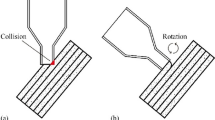Abstract
Maximum resultant cutting force control provides a great benefit of improving productivity in machining tasks. This paper presents a new force control method for robot milling that can prevent force overshoots during abrupt part geometry changes. Firstly, the feedrates of the robot at critical cutter locations are optimized offline according to the cutting force model and the part geometry. Secondly, an online parameter self-adaptive proportional-integral (PI) controller is designed in consideration of the robot feed-direction dynamics and the time-varying first-order model of the cutting process. Finally, the offline scheduled feedrates are integrated into the online adaptive controller via a feedforward-like strategy. Experiments demonstrate the effectiveness and advantages of the proposed force control method.













Similar content being viewed by others
References
Leali F, Vergnano A, Pini F et al (2016) A workcell calibration method for enhancing accuracy in robot machining of aerospace parts. Int J Adv Manuf Technol 85:47–55
Lehmann C, Pellicciari M, Drust M, Gunnink JW (2013) Machining with industrial robots: the COMET project Approach. In: Communications in Computer and Information Science, pp 27–36
Surdilovic D, Zhao H, Schreck G, Krueger J (2012) Advanced methods for small batch robotic machining of hard materials. In: Proceedings of ROBOTIK 2012. Munich, pp 1–6
He J, Pan Z, Zhang H (2007) Adaptive force control for robotic machining process, 1–6
Sörnmo O, Olofsson B, Robertsson A, Johansson R (2012) Increasing time-efficiency and accuracy of robotic machining processes using model-based adaptive force control. IFAC Proc Vol 45:543–548
Altintas Y, Aslan D (2017) Integration of virtual and on-line machining process control and monitoring. CIRP Ann 66:349–352
Matsubara A, Ibaraki S (2009) Monitoring and control of cutting forces in machining processes : a review. Int J Autom Technol 3:445–456
Fussell BK, Jerard RB, Hemmett JG (2001) Robust feedrate selection for 3-Axis NC machining using discrete models. J Manuf Sci Eng 123:214
Ferry WB, Altintas Y (2008) Virtual five-axis flank milling of jet engine impellers—part I: mechanics of five-axis flank milling. J Manuf Sci Eng 130:011005
Budak E, Kops L (2000) Improving productivity and part quality in milling of titanium based impellers by chatter suppression and force control. CIRP Ann 49:31–36
Luo M, Hou Y, Zhang D (2016) Feedrate optimization for worn cutter with measured cutting force in rough milling. IEEE/ASME Int Conf Adv Intell Mechatronics, AIM 2016–Septe: 345–350
Liu Y, Cheng T, Zuo L (2001) Adaptive control constraint of machining processes. Int J Adv Manuf Technol 17:720–726
Landers RG, Ulsoy AG (2000) Model-based machining force control. J Dyn Syst Meas Control 122:521
Rober SJ, Shin YC, Nwokah ODI (1997) A digital robust controller for cutting force control in the end milling process. J Dyn Syst Meas Control 119:146
Landers RG, Ulsoy AG, Ma YH (2004) A comparison of model-based machining force control approaches. Int J Mach Tools Manuf 44:733–748
Elbestawi MA, Sagherian R (1987) Parameter adaptive control in peripheral milling. Int J Mach Tools Manuf 27:399–414
Elbestawi MA, Mohamed Y, Liu L (1990) Application of some parameter adaptive control algorithms in machining. J Dyn Syst Meas Control 112:611
Altintas Y (2012) Manufacturing automation: metal cutting mechanics, machine tool vibrations, and CNC design. Cambridge university press
Lauderbaugh LK, Ulsoy AG (1989) Model reference adaptive force control in milling. J Eng Ind 111:13
Zhang H, Pan Z (2008) Robotic machining: material removal rate control with a flexible manipulator. IEEE Conf Robot Autom Mechatron 2008:30–35
Sörnmo O, Olofsson B, Robertsson A, Johansson R (2015) Learning approach to cycle-time-minimization of wood milling using adaptive force control. J Manuf Sci Eng 138:011013
Stemmler S, Abel D, Schwenzer M et al (2017) Model predictive control for force control in milling. IFAC-Papers OnLine 50:15871–15876
Spence A, Altintas Y (1991) CAD assisted adaptive control for milling. J Dyn Syst Meas Control 113:444
Richards ND, Fussell BK, Jerard RB (2002) Efficient Nc machining using off-line optimized feedrates and on-line adaptive control. 1–11
Saturley PV, Spence AD (2000) Integration of milling process simulation with on-line monitoring and control. Int J Adv Manuf Technol 16:92–99
Fussell BK, Srinivasan K (1989) On-line identification of end milling process parameters. J Eng Ind 111:322
Altintaş Y (1994) Direct adaptive control of end milling process. Int J Mach Tools Manuf 34:461–472
Xiong G, Ding Y, Zhu LM, Su CY (2017) A product-of-exponential-based robot calibration method with optimal measurement configurations. Int J Adv Robot Syst 14:1–12
Xiong G, Ding Y, Zhu L (2019) Stiffness-based pose optimization of an industrial robot for five-axis milling. Robot Comput Integr Manuf 55:19–28
Budak E, Altintaş Y, Armarego EJA (1996) Prediction of milling force coefficients from orthogonal cutting data. J Manuf Sci Eng 118:216
Ghasemi M, Zhao S, Insperger T, Kalmár-Nagy T (2012) Act-and-wait control of discrete systems with random delays. Proc Am Control Conf:5440–5443
Funding
This work was supported by the National Natural Science Foundation of China [Grant No. 91648202, 51822506, 51535004, 51905345] and Shanghai Rising-Star Program [Grant No. 17QA1401900].
Author information
Authors and Affiliations
Corresponding author
Additional information
Publisher’s note
Springer Nature remains neutral with regard to jurisdictional claims in published maps and institutional affiliations.
Rights and permissions
About this article
Cite this article
Xiong, G., Li, ZL., Ding, Y. et al. Integration of optimized feedrate into an online adaptive force controller for robot milling. Int J Adv Manuf Technol 106, 1533–1542 (2020). https://doi.org/10.1007/s00170-019-04691-1
Received:
Accepted:
Published:
Issue Date:
DOI: https://doi.org/10.1007/s00170-019-04691-1




